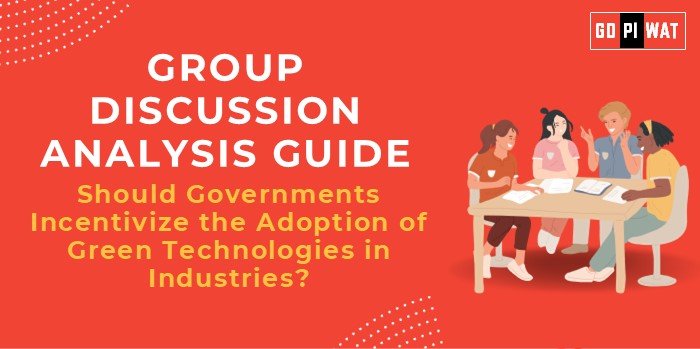📋 Group Discussion Analysis Guide
Should Governments Incentivize the Adoption of Green Technologies in Industries?
🌍 Introduction
- 🌐 Opening Context: The adoption of green technologies is pivotal for achieving global climate goals, fostering sustainable industrial growth while reducing environmental degradation. As industries account for over 20% of global carbon emissions, governments worldwide face pressure to incentivize sustainable practices.
- 📖 Topic Background: Green technologies encompass innovations aimed at minimizing environmental harm, such as renewable energy solutions, waste management systems, and energy-efficient practices. Notable incentives include tax rebates, subsidies, and grants, with countries like Germany leading the way in green industrial policies.
📊 Quick Facts and Key Statistics
- 🌍 Global Emissions by Industry: 20%+ share of global CO2 emissions—highlighting industries’ role in climate challenges.
- 💰 Investment in Renewables (2023): $500 billion globally—showcasing the rising commitment to green innovation.
- 👷 Green Jobs in India: 10 million projected by 2030—indicating employment opportunities tied to green technology adoption.
- ♻️ Carbon Pricing Initiatives: 68 countries as of 2024—showing global efforts to regulate emissions through financial mechanisms.
🌍 Stakeholders and Their Roles
- 🏛️ Governments: Policy formulation, financial support, and regulatory enforcement.
- 🏭 Industries: Adoption and integration of green technologies into production lines.
- 🌱 NGOs and Environmental Groups: Advocating sustainable practices and transparency.
- 👥 Consumers: Driving demand for eco-friendly products.
- 🌐 International Bodies: Setting global standards and facilitating cross-border collaboration.
🏆 Achievements and Challenges
Achievements:
- 🌟 Germany’s Renewable Energy Transformation: 45% of energy from renewables in 2023, aided by government incentives.
- ☀️ India’s Solar Subsidy Scheme: Enabled a 10x growth in solar installations over a decade.
- 🌳 Carbon Footprint Reduction in Norway: A 40% reduction by 2022, showcasing government-industry collaboration.
Challenges:
- 💸 Cost Barriers: High initial investments deter small and medium enterprises (SMEs).
- 🔧 Technological Gaps: Limited access to advanced technologies in developing nations.
- 📜 Regulatory Hurdles: Complex approval processes impede timely adoption.
🌍 Global Comparisons:
- 🇨🇳 China: Subsidized EV production, becoming the largest EV market.
- 🇪🇺 EU: Strict emissions trading systems incentivize sustainable practices.
📖 Case Study: In India, Gujarat’s wind power initiative resulted in a 15% energy cost reduction for participating industries.
💬 Structured Arguments for Discussion
- ✅ Supporting Stance: “Incentivizing green technologies can lead to industrial innovation, job creation, and significant emissions reduction.”
- ❌ Opposing Stance: “Subsidies for green tech may burden taxpayers without guaranteeing widespread adoption.”
- ⚖️ Balanced Perspective: “While government incentives can catalyze green adoption, their design must minimize financial inefficiencies and maximize impact.”
🗣️ Effective Discussion Approaches
Opening Approaches:
- 📊 Highlight the economic impact of transitioning to green technologies, e.g., job creation.
- 📖 Use global success stories like Germany or China to illustrate potential benefits.
Counter-Argument Handling:
- 💡 Acknowledge financial burdens but emphasize long-term savings and environmental gains.
- 🌐 Address technological disparities with proposals for international collaboration.
📊 Strategic Analysis: SWOT
- 💪 Strengths: Boosts innovation, reduces emissions, enhances energy efficiency.
- ❌ Weaknesses: High costs, dependency on subsidies, implementation challenges.
- 🌟 Opportunities: Export of green tech, global partnerships, R&D growth.
- ⚠️ Threats: Policy inconsistencies, lack of skilled workforce, market resistance.
🎓 Connecting with B-School Applications
- 🌐 Real-World Applications: Case studies in operations, sustainability, and policy-making.
- 🎯 Sample Interview Questions:
- “How can India balance industrial growth with environmental sustainability?”
- “What lessons can India learn from Germany’s green tech policies?”
- 📘 Insights for Students:
- Explore how sustainability strategies impact finance, marketing, and production.


